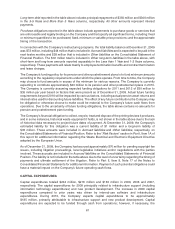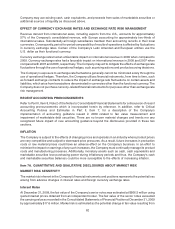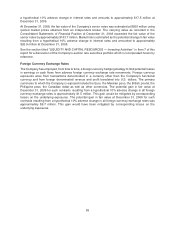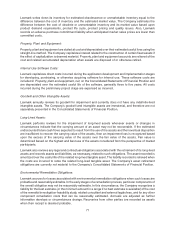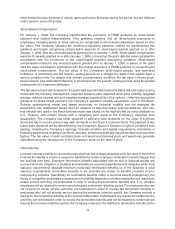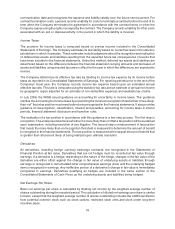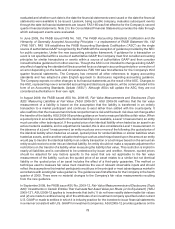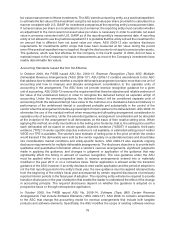Lexmark 2009 Annual Report Download - page 75
Download and view the complete annual report
Please find page 75 of the 2009 Lexmark annual report below. You can navigate through the pages in the report by either clicking on the pages listed below, or by using the keyword search tool below to find specific information within the annual report.observable inputs and minimizes the use of unobservable inputs by requiring that the most observable
inputs be used when available.
The Company generally uses a market approach, when practicable, in valuing financial instruments. In
certain instances, when observable market data is lacking, the Company uses valuation techniques
consistent with the income approach whereby future cash flows are converted to a single discounted
amount. The fair value of cash and cash equivalents, trade receivables, trade payables and short-term
debt approximates their carrying values due to the relatively short-term nature of the instruments. The fair
value of Lexmark’s marketable securities are based on quoted market prices or other observable market
data or in some cases, internally developed inputs and assumptions (discounted cash flow model) when
observable market data does not exist.
The fair value of long-term debt is estimated based on the prices the bonds have recently traded in the
market as well as prices of debt with similar characteristics issued by other companies. The fair value of
derivative financial instruments is based on pricing models or formulas using current market data, or where
applicable, quoted market prices.
Starting in 2009, in response to newly issued fair value accounting guidance, the Company implemented
more comprehensive procedures to review the number of pricing inputs received as well as the variability in
the pricing data utilized in the overall valuation of its marketable securities. For securities in which the
number of pricing inputs is less than expected or there is significant variability in the pricing inputs, the
Company tests that the price is within a reasonable range of fair value through corroboration with other
sources of market data. Refer to Recent Accounting Pronouncements within this footnote for information
regarding the fair value guidance issued and effective in 2009.
In determining where measurements lie in the fair value hierarchy, the Company uses default assumptions
regarding the general characteristics of each type of security as the starting point. The Company then
downgrades individual securities to a lower level as necessary based on specific facts and circumstances.
The Company also applies the fair value framework to nonrecurring, nonfinancial fair value
measurements, beginning in 2009 in accordance with the accounting guidance. These measurements
include such items as impairment of held and used fixed assets, long-lived assets held for sale, and
goodwill impairment testing. The valuation approach(es) selected for each of these measurements
depends upon the specific facts and circumstances.
Marketable Securities:
Based on the Company’s expected holding period, Lexmark has classified all of its marketable securities
as available-for-sale and the majority of these investments are reported in the Consolidated Statements of
Financial Position as current assets. The Company’s available-for-sale auction rate securities have been
classified as noncurrent assets since the expected holding period is assumed to be greater than one year
due to failed market auctions of these securities. Realized gains or losses are derived using the specific
identification method for determining the cost of the securities.
The Company records its investments in marketable securities at fair value through accumulated other
comprehensive earnings using the valuation practices discussed in the previous fair value section. Once
these investments have been marked to market, the Company must assess whether or not its individual
unrealized loss positions contain other-than-temporary impairment (“OTTI”). Based on new accounting
guidance issued and effective in 2009, the Company recognizes OTTI in earnings for the entire unrealized
loss position if the entity intends to sell or it is more likely than not the entity will be required to sell the debt
security before its anticipated recovery of its amortized cost basis. If the Company does not expect to sell
the debt security, but the present value of cash flows expected to be collected is less than the amortized
cost basis, a credit loss is deemed to exist and OTTI is recognized in earnings.
69




